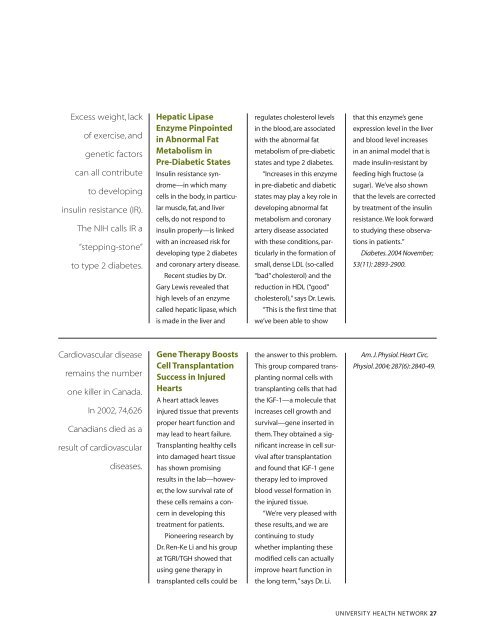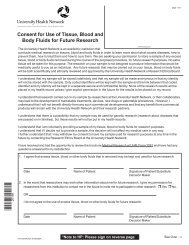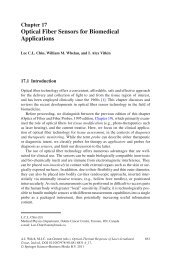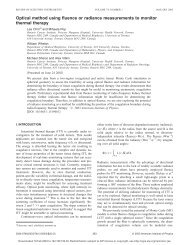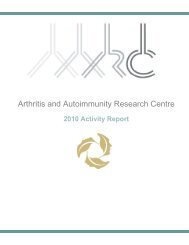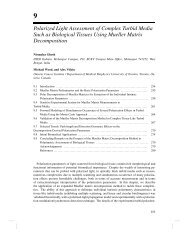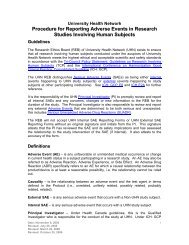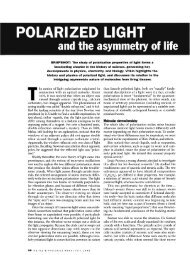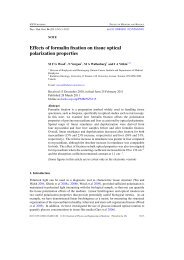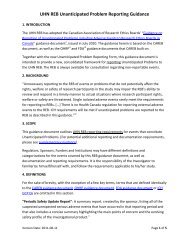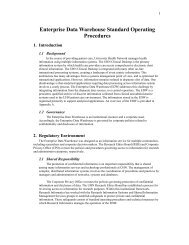Download the 2005 pdf - UHN Research
Download the 2005 pdf - UHN Research
Download the 2005 pdf - UHN Research
Create successful ePaper yourself
Turn your PDF publications into a flip-book with our unique Google optimized e-Paper software.
Excess weight, lack<br />
of exercise, and<br />
genetic factors<br />
can all contribute<br />
Hepatic Lipase<br />
Enzyme Pinpointed<br />
in Abnormal Fat<br />
Metabolism in<br />
Pre-Diabetic States<br />
Insulin resistance syn-<br />
regulates cholesterol levels<br />
in <strong>the</strong> blood, are associated<br />
with <strong>the</strong> abnormal fat<br />
metabolism of pre-diabetic<br />
states and type 2 diabetes.<br />
“Increases in this enzyme<br />
that this enzyme’s gene<br />
expression level in <strong>the</strong> liver<br />
and blood level increases<br />
in an animal model that is<br />
made insulin-resistant by<br />
feeding high fructose (a<br />
to developing<br />
drome—in which many<br />
cells in <strong>the</strong> body, in particu-<br />
in pre-diabetic and diabetic<br />
states may play a key role in<br />
sugar). We’ve also shown<br />
that <strong>the</strong> levels are corrected<br />
insulin resistance (IR).<br />
The NIH calls IR a<br />
lar muscle, fat, and liver<br />
cells, do not respond to<br />
insulin properly—is linked<br />
developing abnormal fat<br />
metabolism and coronary<br />
artery disease associated<br />
by treatment of <strong>the</strong> insulin<br />
resistance. We look forward<br />
to studying <strong>the</strong>se observa-<br />
“stepping-stone”<br />
with an increased risk for<br />
developing type 2 diabetes<br />
with <strong>the</strong>se conditions, particularly<br />
in <strong>the</strong> formation of<br />
tions in patients.”<br />
Diabetes. 2004 November;<br />
to type 2 diabetes.<br />
and coronary artery disease.<br />
Recent studies by Dr.<br />
small, dense LDL (so-called<br />
“bad” cholesterol) and <strong>the</strong><br />
53(11): 2893-2900.<br />
Gary Lewis revealed that<br />
reduction in HDL (“good”<br />
high levels of an enzyme<br />
cholesterol),” says Dr. Lewis.<br />
called hepatic lipase, which<br />
“This is <strong>the</strong> first time that<br />
is made in <strong>the</strong> liver and<br />
we’ve been able to show<br />
Cardiovascular disease<br />
remains <strong>the</strong> number<br />
one killer in Canada.<br />
In 2002, 74,626<br />
Gene Therapy Boosts<br />
Cell Transplantation<br />
Success in Injured<br />
Hearts<br />
A heart attack leaves<br />
injured tissue that prevents<br />
<strong>the</strong> answer to this problem.<br />
This group compared transplanting<br />
normal cells with<br />
transplanting cells that had<br />
<strong>the</strong> IGF-1—a molecule that<br />
increases cell growth and<br />
Am. J. Physiol. Heart Circ.<br />
Physiol. 2004; 287(6): 2840-49.<br />
Canadians died as a<br />
proper heart function and<br />
may lead to heart failure.<br />
survival—gene inserted in<br />
<strong>the</strong>m. They obtained a sig-<br />
result of cardiovascular<br />
diseases.<br />
Transplanting healthy cells<br />
into damaged heart tissue<br />
has shown promising<br />
nificant increase in cell survival<br />
after transplantation<br />
and found that IGF-1 gene<br />
results in <strong>the</strong> lab—howev-<br />
<strong>the</strong>rapy led to improved<br />
er, <strong>the</strong> low survival rate of<br />
blood vessel formation in<br />
<strong>the</strong>se cells remains a con-<br />
<strong>the</strong> injured tissue.<br />
cern in developing this<br />
“We’re very pleased with<br />
treatment for patients.<br />
<strong>the</strong>se results, and we are<br />
Pioneering research by<br />
continuing to study<br />
Dr. Ren-Ke Li and his group<br />
whe<strong>the</strong>r implanting <strong>the</strong>se<br />
at TGRI/TGH showed that<br />
modified cells can actually<br />
using gene <strong>the</strong>rapy in<br />
improve heart function in<br />
transplanted cells could be<br />
<strong>the</strong> long term,” says Dr. Li.<br />
UNIVERSITY HEALTH NETWORK 27


